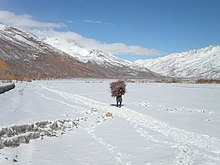Wakhi people
The machinations of The Great Game during the eighteenth and nineteenth century created boundaries which separated the large body of the Wakhis into living in four countries.In Gilgit-Baltistan in the north of Pakistan, Wakhi predominantly live in the upper region of Hunza popularly known as Gojal.[citation needed] In Pakistan, Wakhi also live in Broghal in Chitral district of Khyber Pakhtunkhwa province.In China, Wakhi are inhabitants of Taxkorgan Tajik Autonomous County an administrative area within Kashgar Prefecture of Xinjiang, mainly in the township of Dafdar.[citation needed] The Wakhi predominantly adhere to Nizari Ismaili Shia Islam, which is regarded as their ethnic religion and are followers of the Aga Khan.

Chapursan ValleyGilgit−BaltistanPakistanAfghanistanTajikistanIsma'ili ShiaIranian peoplesShughniPersianRussianChineseIranianCentralSouth AsiaWakhan CorridorChitralGorno−Badakhshan Autonomous RegionXinjiang Uyghur Autonomous RegionWakhi languageEastern Iranian languageexonymWakhanOxus RiverVakhshGulmitGilgit-BaltistanXinjiangThe Great GameRoshtqal'a DistrictIshkoshim DistrictGorno-Badakhshan Autonomous RegionWakhan DistrictBadakhshan ProvinceKhyber PakhtunkhwaTaxkorgan Tajik Autonomous CountyKashgar PrefectureDafdarSarikoli peopleTajiksPamiriGujaliNizariIsmailiShia Islamethnic religionAga KhannomadicRadio PakistanAfroze-NumaPamirisWakhan MountainsPamir MountainsEthnic groups in AfghanistanBalochBrahuiGurjarsMogholNuristanisPashayiPashtunsPunjabisTurkicHazarasKyrgyzQizilbashTurkmensUzbeksArmeniansIndiansPakistanisRussiansEthnic groups in PakistanAfghansDehwarKhetranBengalisBiharisBroqpaBurushoDograsEuropeanBritishGujaratiGurjarHindkowansIndus KohistaniKalashKashmirisLadakhiMarwariMuhajirsGujaratisMemonsRajasthanisTamilsUrdu speakersPaharisPalulaSariquliShughnanYidghaSpin TareenPurigpaRajasthaniSalvi MewarSaraikiSindhisJadgalKutchiMeghwar BhilTorwalTurkmenUyghursImmigration to PakistanAmericansCanadiansRohingyaMaldiviansNepalisPalestiniansYemenisFilipinosIndonesiansIraniansEuropeBritons